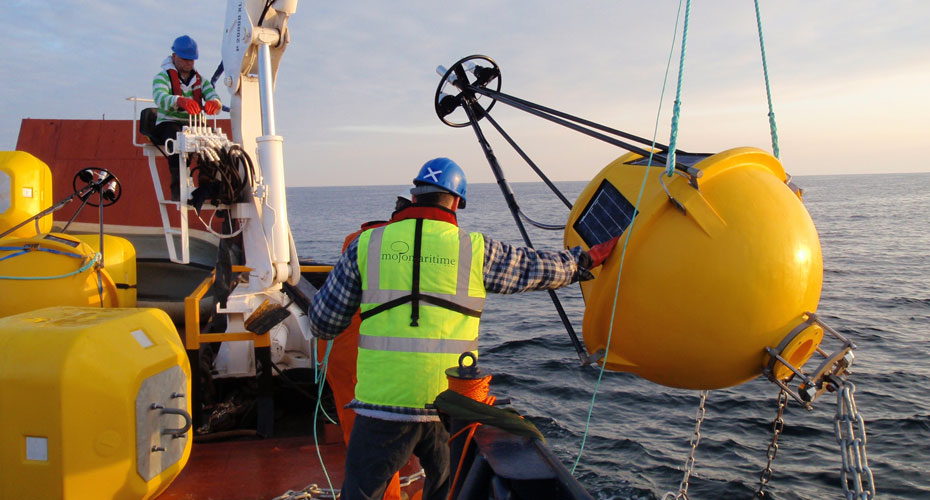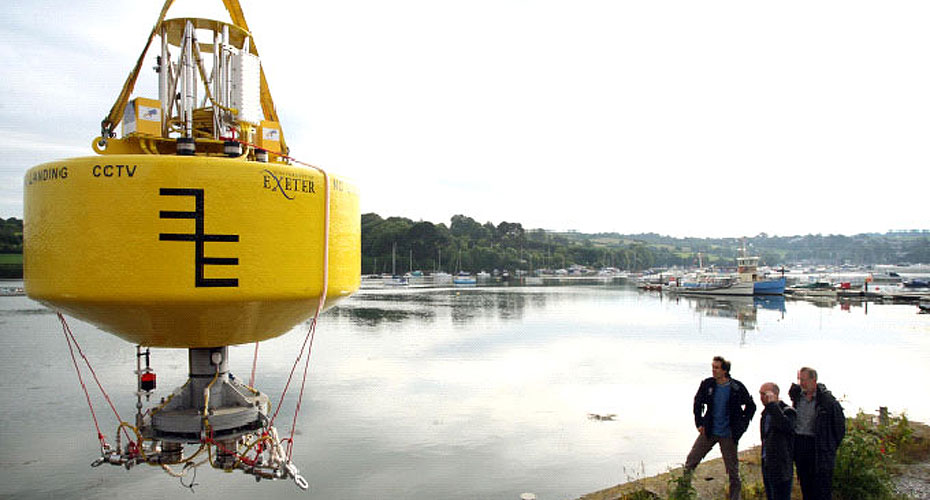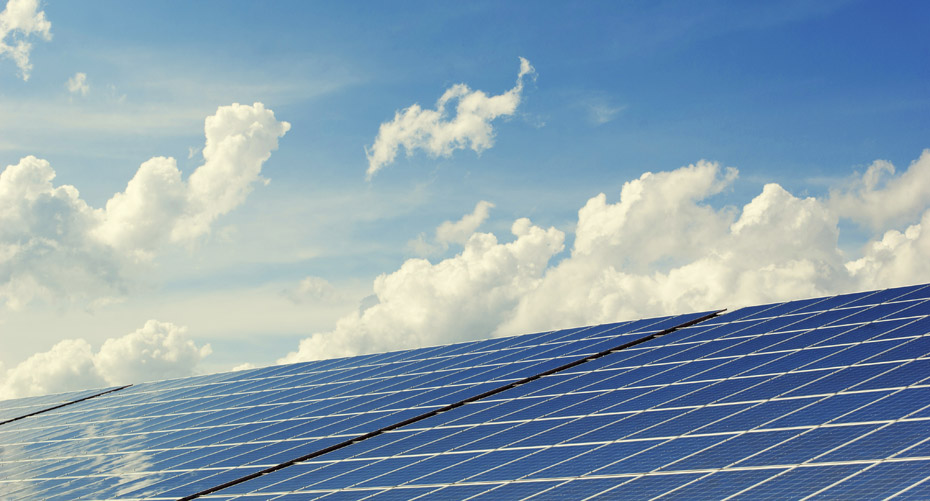- Engineering
- Renewable Energy
- Facilities
Facilities
Renewable Energy has access to significant specialist resources and equipment applicable to the renewable energy sector, in addition to the majority of conventional engineering laboratory facilities. Most of our unique facilities relate to ocean energy research, power systems and reliability and field studies. These have relevance both for fundamental research, industrial projects and for teaching purposes.
If you are interested in using the facilities and would like to know more about them please contact the named person for each facility.
Offshore and marine energy facilities

Falmouth Bay test site (FaBTest)
FaBTest is a pre-consented test area for offshore renewable energy, located within Falmouth Harbour and with easy access to the extensive port infrastructure. This 2.8km2 nursery facility is sheltered from the extreme sea conditions experienced at other test sites, and thus enables device developers to test components, concepts or full-scale devices in a moderate wave climate.
The site offers water depths of 20m-50m and seabed types of rock, gravel and sand, and its pre-consented status enables a fast, flexible, low risk and low cost solution for the testing of marine energy technologies, components, moorings and deployment procedures.
Email: info@fabtest.com
Dynamic Marine Component test facility (DMaC)
The Dynamic Marine Component Test facility (DMaC) is a purpose built test rig that aims to replicate the forces and motions that components are subjected to in offshore applications. The test rig comprises a linear hydraulic cylinder that can be used to replicate axial tension/compression force, and a headstock with three degrees of freedom representative of x- and y-bending and torsion. Download the DMaC specification sheet.
Address: DMaC (building 420), The Docks, Falmouth, Cornwall, TR11 4NR
Telephone: 01326 218168 or< 01326 255751
Email: DMAC@exeter.ac.uk
Research vessel
Offshore Energy research is supported by our dedicated research vessel ‘DevOcean’. Classified MCA Category 2 (12 passengers + 2 crew), the 10.5m vessel has a large deck area for working and a 250kg winch, and is primarily used for ROV work and instrument deployment and servicing.
Contact: Professor Lars Johanning
Offshore instrumentation
The Offshore Energy group owns and operates three wave buoys (2 x SeaWatch Mini II, 1 x Datawell Waverider) and two 4-beam (600kHz and 300kHz) and one bespoke 5-beam 300kHz RDI Sentinel ADCPs for recording in situ wave and current data to support our offshore research projects and FaBTest operation. Additional instrumentation includes a VideoRay Pro 4 remotely operated vehicle (ROV) for underwater surveys, WASSP multibeam sonar and SeaPro dropped and towed cameras.
Contact: Professor Lars Johanning
High Performance Computing cluster
The Offshore Energy group has a dedicated 32 node Beowulf cluster to support the high performance computing requirements of our researchers. Running software such as the SWAN wave model and Delft3D Flow, this facility enables us to run state-of-the-art modelling simulations for resource, engineering and environmental impact analysis.
Contact: Professor Lars Johanning
Laboratories and centres

Electrical power systems laboratory
This laboratory has state of the art simulation software along with a Real Time simulation system. Additionally the laboratory has the capability of integrating small machine and for testing power conditioning systems.
Contact: Dr Mohammad Abusara
Environment and Sustainability Institute (ESI)
The Environment and Sustainability Institute is a world-class research institute finding cutting-edge solutions to complex problems of environmental change. The challenges we address are global in scale, but we develop solutions in partnership with Cornish businesses, which has a direct impact on the regional economy.
Contact: esienquiries@exeter.ac.uk
Science and Engineering Research Support Facility (SERSF)
The SERSF building is home to offshore renewables laboratories, and also features a specially designed area for business engagement called ‘The Collaboratory’.
Renewable Energy Engineering Facility (REEF)
The Renewable Energy Engineering Facility (REEF) provides a number of exciting opportunities for students on the Renewable Energy programmes. It houses an engineering workshop where students are able to design, build and test projects to support their studies. The facility also has operational renewable energy technologies that students are able to conduct experiments on or compare the outputs of with their simulations and calculations.
Engineering laboratory
Experiments and demonstrations of the fundamental engineering principles are run in the Engineering laboratory in the Daphne Du Maurier building. With equipment demonstrating the generic engineering concepts as well as renewable energy specific technologies the lab supports modules in all years of the programme. In addition to the engineering equipment there is an IT suite with computers running specialist software for modelling renewable energy technologies, mapping projects and designing components.
Energy storage

Contact: Prof. Xiaohong Li
Materials synthesis and fabrication:
Catalyst and electrode materials are created using a range of techniques including chemical processes such as thermal decomposition, electrochemical processes such as electroplating, thermal treatments such as calcination or annealing, hot pressing and spray coating. The nature and performance of these materials can then be investigated using the electrochemical and characterisation techniques outlined below. This allows for the relationships between synthesis methods, material characteristics and electrochemical performance to be established. Further optimisation can then be conducted in order to develop novel, cost effective and high performance materials for electrochemical energy storage devices.
Fundamental Electrochemistry:
Laboratory scale electrochemical research allows studies of reaction kinetics, catalyst and electrode materials and electroplating. Potentiostats are used to employ techniques including cyclic voltammetry, linear sweep voltammetry, electrochemical impedance spectroscopy and chronoamperometry. Rotating electrodes are especially useful for studying the kinetics of the electrochemical reactions involved in batteries, electrolysers and fuel cells, while hull cells are utilised to investigate electroplating processes under varying conditions such as current density and electrolyte compositions. Microelectrodes are employed for rapid screening of catalyst materials as they allow data to be recorded at significantly low iR drop. The application of these techniques allows novel electrodes, electrolytes, catalysts and full cell systems to be developed and optimised at small scale, before integration and scaling up for commercialisation.
Material Characterisation:
A number of techniques are available to characterise materials for energy storage such as catalysts, electrodes and membranes, in order to relate their properties to electrochemical performance. The morphology of materials can be investigated using Scanning Electron Microscopy (SEM) and Transmission Electron Microscopy (TEM), while their chemical composition can be established using Energy Dispersive Spectroscopy (EDS) and X-ray diffraction (XRD).
The structure and porosity of three-dimensional materials can be studied using x-ray computed tomography (X-CT) and electrical and magnetic properties established through atomic force microscopy (AFM). These facilities enable the development of novel, high performance materials for use in electrochemical energy storage devices. For more information on the equipment and capabilities available, please view our dedicated 'characterisation facilities' webpage.
Device Testing:
Using battery cycling equipment electrochemical devices such as batteries, electrolysers and fuel cells can be tested for performance and durability. Up to eight devices can be tested simultaneously, at currents up to 15 A and potentials up to 9 V. Due to the modularity of the system, the channels can be linked in parallel to test larger devices at currents up to 120 A.
To enable development and testing of catalyst materials and membrane electrode assemblies (MEA) for electrolysis, two solid polymer electrolyte electrolysers are available with electrode areas of 10 cm2 and 100 cm2.
Two redox flow cells are also available to test a range of battery chemistries in either membraned or membrane free configurations, with electrode sizes of 1 cm2 and 25 cm2. Peristaltic pumps are employed in order to prevent contamination and corrosion by avoiding contact between the pump components and the pumped fluid.
Solar energy

Contact: Professor Tapas Mallick
Large area continuous solar simulator
The WACOM (Continuous) Solar Simulator is used for evaluation of properties of solar cells and small sized modules. This system irradiates continuous light, which is similar to sunlight in spectral distribution (A.M.1.5) and intensity (1Sun), over a 210 x 210mm area.
Combined with a 5D rotational table, this enables the creation of environmental conditions anywhere on the planet within 10-80 degree latitudes. The computer-controlled simulator automatically adjusts the solar radiation and position of the sun during the day and time of the year, to create conditions related to the given location on the earth.
Solar simulator - Flash
The Flash type Pasan SunSim Solar module tester is one of the first of its kind in the UK. Having a Class A+A+A+ certification, it is two times better than the best class A solar simulators. The equipment is used for testing standard crystalline silicon-based modules, as well as new technologies like the thin-films. It is capable of testing solar modules up to 2m x 2m.
Impedance spectroscopy (IS)
Impedance spectroscopy can be used to:
- distinguish between two or more electrochemical reactions taking place,
- view diffusion through a passive film,
- provide information on the capacitive behaviour of the system,
- and provide information about the electron transfer rate of reaction.
In our solar lab, Metrohm Autolab impedance spectroscopy is used to monitor the corrosion or discharge of fuel cells and investigate the properties and quality of dye-sensitised and perovskite solar cell devices.
External quantum efficiency (EQE) / Internal quantum efficiency (IQE)
EQE and IQE reveal the cell performance for a particular wavelength. The PVE300 system from Bentham enables us to obtain EQE and IQE for solar cells. The PVE300 is fully automated through the USB interface and controlled by the Benwin+ windows software. It directly reports measurement results including spectral response, EQE, IQE and AM1.5 for all types of photovoltaic devices and architectures: c:Si, mc:Si, a:Si, µ:Si, CdTe, CIGS, CIS, CZTS, Ge, dye-sensitised, organic/polymer, multi-junction (2-, 3-, 4– junctions and more), quantum well, quantum dot, chalcogenides and perovskites.
Spectrophotometer
A spectrophotometer measures the reflection or transmission properties of a material as a function of wavelength. The LAMBDA 1050 UV/Vis/NIR has potential to measure 175 nm to 3300nm wavelength. It is capable of achieving a greater level of sensitivity, resolution and speed in the NIR (800-2500nm) range, and simplifies the analysis of difficult samples such as high absorbing glass, optical coatings or thin film filters.
SOPRA ellipsometer
Ellipsometry is a method based on measurement of the change of the polarization state of light after reflection at non normal incidence on the surface to study. The system helps in carrying out photometry including Transmission, Reflection, Scatterometry, and luminescence measurements. All measurements are made automatically as a function of: wavelength, angle of incidence, polarization state and time. Standard spectral range is 230-900nm, and can be extended in both DUV and NIR regions.
Gas chromatography
The Clarus 580 Gas Chromatograph is used for qualitative and quantitative analysis of solar fuel and environmental pollutants. The Gas Chromatograph (GC) is a highly responsive piece of equipment, which is able to detect small traces of gas molecules in small volumes injected into the GC column (which is a molecular sieve). The gasses are separated by the column based on retention time due to the size of the gas molecules and then are detected by a detector producing a graph. An inert gas (argon) is used as the mobile phase to pass the sample through the column (a solid stationary phase). We use the GC to detect if any hydrogen is being produced in our water splitting reactions.
Smart grid setup
Grid voltage support during symmetrical and asymmetrical AC faults, and protection and fault isolation during DC faults are significant challenges for converter operations and control in order to deliver a highly reliable, versatile community energy solutions.
We offer real-time micro grids (DC or AC) for simulators, which can implement a host of commands and control algorithms in any DG convertor to replicate the real time loads, and analyses the performance of the micro grid in real time.
Photo/Electro-luminescence set
This set-up utilises the electro-luminescence phenomenon to image micro cracks, cell failures and in-homogeneities of wafers and solar cells which are extremely difficult to detect visually. The equipment was developed for research and off-line solar inspection, therefore detailed quality control is enabled.
Differential scanning calorimeter (DSC)
DSC is used for thermal characterisation of materials including polymers. DSC can detect melting temperatures and enthalpies (heats of fusion), crystallization temperatures and enthalpies, glass transition temperatures, oxidative-induction time (OIT) and oxidative onset temperature (OOT), degree of crystallinity, reaction temperatures and enthalpies, cross-linking reactions (curing), degree of curing, specific heat capacity, distribution of molecular weight (peak shape). The process involves sample preparation, evaluation and interpretation of the resulting curves. We offer the DSC 214 Polyma from Netzsch.
Outdoor test facilities
Our outdoor test facilities comprise a sun tracker (SOLYS) to measure direct and diffuse solar radiation, weather station (MetPak Pro) to measure wind speed and humidity, high spec IR (infrared) cameras, calibrated solar cells and sun sensors. A south facing and inclined (local latitude angle) test rig for photovoltaic (PV) devices enables outdoor experiments and measurement of PV power throughout the year.
SOLYS can be configured as a complete solar monitoring station with up to three ventilated radiometers. The MetPak Pro Base Station features an on-board barometric pressure sensor temperature/humidity probe essentially used for weather monitoring. We have Kipp and Zonnen type pyranometers for sun sensor and a dual axis large area (6m by 6m) solar tracker.
Computational faculties
The Solar Energy group has access to various computational modelling software. This includes Computer Aided Design, Finite Element Analysis, Optical ray tracing and basic programming. Special software for carrying out the PV system analysis is also available to model the available solar radiation at any given location and identify the PV power outputs we can achieve through it. These include:
- Optical ray tracing (ASAP, APEX)
- Finite element (COMSOL, ANSYS)
- Cad (Solid Works)
- PV software (PVSYST, TRNSYS)
- Programming (MATLAB)



